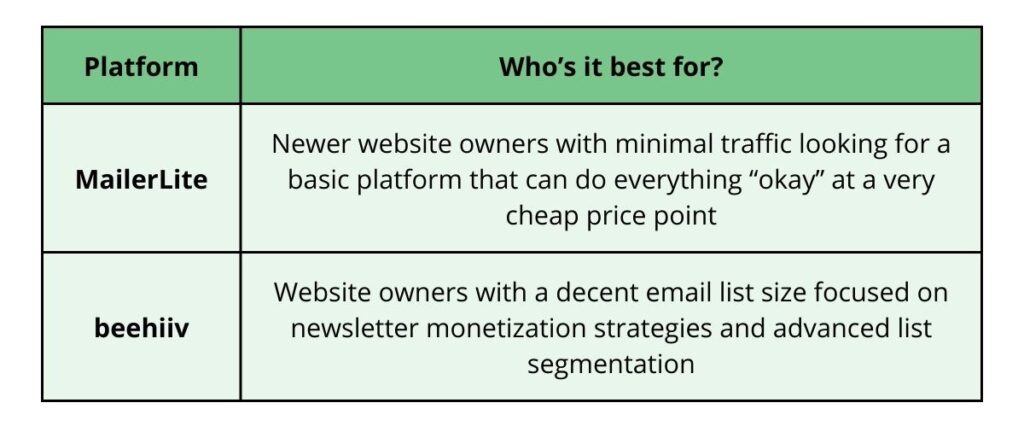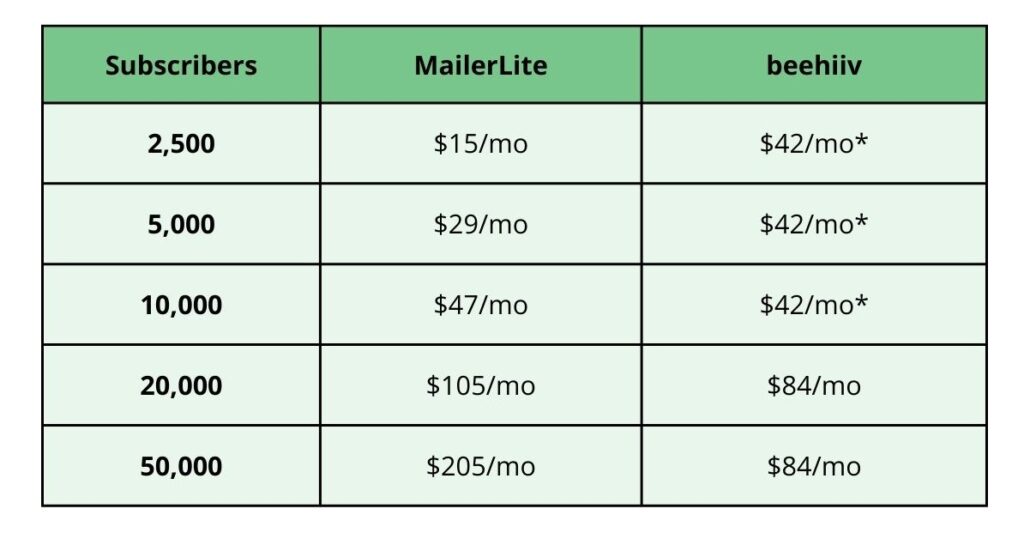With so many email marketing platforms available, it can be extremely overwhelming to figure out which to go with. We’ve tested several in the 10+ years we’ve been doing email marketing, and we’ve found some that work great for the website-building community.
Specifically, two of those notable platforms are beehiiv and MailerLite.
We’ll dive into these two popular platforms to help you decide which is best for you if and when you’re ready to build an email list (which you should definitely be doing!).
beehiiv vs MailerLite – which should we use and when?

A few caveats: we attempted to be as accurate as possible with everything we shared below. Seriously, these are both awesome options, and we wanted to use data to guide our thoughts. If anything is incorrect, apologies (and let us know). There are affiliate links to the email platforms in this, but we don’t have any specific affiliations with any of them.
Quick Navigation
beehiiv vs MailerLite
To start, here’s a quick breakdown of both platforms:
- beehiiv is a newer platform (launched in 2021) with enticing monetization features and attractive pricing as you scale.
- MailerLite makes it easy to collect email subscribers with popups and forms and decent automation features to personalize a subscriber’s experience.
Both can do more than just send emails, including designing webpages and helping you sell digital products. I’m going to keep this article focused on features you’d likely be interested in when building your email list.
TLDR – you can get a quick idea of our analysis by checking out the chart below and reading the verdict at the end.
Take a look at the notable features of MailerLite and beehiiv to see how they stack up:

Price
Let’s begin by reviewing the pricing, as it lays the foundation for the subsequent features I’ll cover. Understanding the price points is crucial because many of the features I’ll mention later are contingent on the specific plan you choose. So, having a clear understanding of the pricing upfront is essential to make an informed decision. (*Note: I’m sharing all the pricing based on signing up for an annual plan, not monthly plans)
MailerLite
If you’re looking for a platform that fulfills your basic email sending, segmenting, and workflow design needs and offers the best value for your money, MailerLite stands out as an excellent choice.
In fact, MailerLite’s free plan, which allows up to 1,000 subscribers, is pretty generous. It provides access to the majority of essential features required to kickstart your subscriber list-building efforts.
While the free plan offers an impressive array of features, there are a few notable limitations to be aware of. It lacks premade email templates, the ability to incorporate dynamic content for enhanced personalization, and unlimited monthly email sends (you’re capped at 12,000 emails per month).
However, when the time comes to upgrade to a paid plan to unlock these additional features and send more emails, MailerLite’s pricing is undeniably attractive, especially when compared to beehiiv.
Starting as low as $9 per month for up to 1,000 subscribers, MailerLite’s pricing structure ensures cost-effectiveness without compromising on crucial functionalities (note that you can be on the free plan with up to 1,000 contacts, but to access advanced features, a paid plan is necessary).
From there, the pricing gradually increases:
- Up to 2,500 subscribers: $15/mo
- Up to 5,000 subscribers: $29/mo
- Up to 8,000 subscribers: $31/mo
- Up to 10,000 subscribers: $47/mo
- Up to 15,000 subscribers: $77/mo
As your subscriber count reaches the 15,000 mark, MailerLite’s pricing becomes comparable to beehiiv’s Scale Plan. However, until then, MailerLite is the most budget-friendly option while you focus on expanding your email list. It’s an excellent choice for beginners seeking a platform with decent features that won’t break the bank.
beehiiv
beehiiv’s pricing structure is refreshingly transparent and easy to understand. With a free plan that supports up to 2,500 subscribers, it surpasses MailerLite’s 1,000 subscribers, which can be enticing for beginners.
However, while the free plan allows unlimited email sends and form creation, unlocking the full potential of segmentation, automation, and most monetization tools requires an upgrade.
You’ll pay a steep price of $84 per month to access these advanced features. This can be pretty costly, especially if you’re just starting. However, the upside is that beehiiv allows you to scale up to 100,000 subscribers, offering a better deal in terms of subscriber capacity compared to MailerLite.
Now, beehiiv does have a cheaper plan available at $42 per month. But, you’ll have to upgrade if you aim to send segmented emails or create automated email workflows.

All prices based on annual billing
*at $42/mo, you will not have access to sending emails blasts out to segments or creating automated email workflows. We think this is a valuable feature though, and you would need to upgrade to the $84/mo plan!
Segmentation
Segmentation is the secret sauce that can really help you gain positive results with your email marketing efforts. In a nutshell, it allows you to categorize your contacts into highly targeted groups, enabling you to personalize the content you send to them.
Whether you segment based on location, engagement levels, or specific website interactions, this strategic approach is vital for captivating your audience online.
Don’t think segmentation matters for emails? What if I told you that you only have 11 seconds to capture someone’s attention with your email?
After 11 seconds, most have clicked out of your email. If you continue to blast generic messages to your entire audience, you risk alienating them or losing their interest altogether.
While there are various email strategies to keep your recipients engaged, segmenting your list and delivering tailored content to specific segments is a powerful starting point. Trust me, it’s a game-changer!
For example, let’s say you have a website on Fitness. You might segment your list by people interested in the following:
- Pilates
- Kickboxing
- Yoga
- Etc
Or, you could segment your list based on equipment they prefer to use:
- Dumbbells
- Kettlebells
- Jump rope
- Resistance bands
- Etc
Or you could segment based on experience level: Beginner, Intermediate, Expert.
Another option is to segment your list based on engagement. Those who are really engaged get certain emails (and usually more), whereas people who are less engaged get fewer emails.
You get the idea. This is one of the areas we focus on at our agency (and it’s pretty fun!).
Both beehiiv and MailerLite allow you to create segmented lists and send those lists emails. Additionally, both let you build static, dynamic, and manual lists (though the exact terminology within each platform varies).
beehiiv
Overall, there’s no contest when it comes to segmentation. beehiiv’s is much stronger than MailerLite’s. This is because of the numerous conditions and logic you can adjust for in a given segment.
Whether you want to segment based on the subscriber’s signup channel, email engagement metrics, custom fields, or a combination of multiple factors, beehiiv enables you to build very specific lists that truly capture what personalization and segmentation are all about.
So, what’s the catch?
While it’s possible to create Audience Segments on their Grow Plan, if you want to email these segements, you need to upgrade to their Scale Plan ($84/mo). Again, if you’re just starting, this price point might be out of your budget.

However, if you built a substantial email following and are serious about maximizing engagement through email, beehiiv is well worth considering. Plus, paired with their monetization features (which I’ll talk more about below), you can create targeted emails and generate money from each send.
MailerLite
MailerLite includes segmentation in all plans, including their free ones. This is nice, especially since you have to be on beehiiv’s Scale Plan to take advantage of segmentation fully.
With MailerLite, you can group contacts by basic filters such as location, specific custom fields, and signup date. It’s not as robust as beehiiv’s, but you’ll still have decent options for segmenting your list.
If anything, MailerLite is a great platform to begin learning about segmentation and get your wheels spinning for what’s possible. You can be on a free (or very cheap) plan to play around with this feature and create basic segments. Though, once you master the basics and realize what’s possible with segmenting, you’ll likely want to upgrade to a stronger platform like beehiiv.
Automation
Automation is one of my favorite features to dive into within email platforms, because it can elevate your entire email strategy. It’s a more advanced email technique, but your results can skyrocket if you set everything up properly.
Other common terms for this are email responder series or email workflows.
In a nutshell, automations let you strategically build out complex email sequences that your contacts can automatically enter into based on certain criteria or triggers. For example, they might sign up for a free guide you offered through a popup, make a purchase on your site, or click on a specific link within an email.
Paired with segmentation, this is an excellent way to engage your subscribers and deliver them content personalized to their specific interests.
MailerLite
Regarding automation workflows, MailerLite is decent – not amazing, but also not terrible. While you can create workflows with basic triggers and conditions, don’t expect them to blow your mind.
To give credit where it’s due, MailerLite has made noticeable improvements in their workflows over the years. While they’re nowhere near the types of automated workflows you can create in a marketing platform like Hubspot, most niche website owners also don’t need that type of complexity in their workflows.
So, even though MailerLite is just okay in this category, it’s usually good enough for business owners who are just starting their mailing list.
Now, MailerLite is currently better than beehiiv when it comes to automation, specifically when it comes to mapping out a subscriber’s journey.
Here’s what I mean by that: With beehiiv, you can only send subscribers down one path per automation, whereas MailerLite provides more customizability.
For example, the automated workflows can “branch out” based on specific conditions (such as how subscribers interact with certain emails) or actions (such as adding/ removing them from a group). You can’t do this with beehiiv.

beehiiv
When it comes to automation, beehiiv leaves much to be desired. Yet again, you’ll need to shell out for their priciest plan just to access Automated Journeys (their version of “automation”). And even then, the level of customization offered is underwhelming, to say the least. For example, ConvertKit and MailerLite do it much better.
You’re provided only a handful of options for how someone enters the workflow. But that’s not the end of it—within the workflow itself, your only action to select is sending emails, and the only control you have is setting the delay time between each message.
Initially, this might not sound like a big deal. But, with this limitation, here are some things you won’t be able to do (that you could in MailerLite):
- Retarget subscribers based on what they click within an email
- Update a custom field based on users interacting with a certain email
- Skip certain steps and emails in an automation sequence based on a group or list the contact is a part of
Another downside is that all users within the sequence are forced down the same path, regardless of their interactions with the emails or the data you’ve collected about them.

You can’t add in conditions or other triggers to allow the automation to branch out into other segments, providing a more personalized journey for someone.
There is hope for beehiiv though! The good news is that their Automated Journeys launched in December 2022, and they are actively optimizing and improving this feature. They still have a long way to go to be on the same playing field as MailerLite, but I’m glad they’re putting effort into updating this.
Deliverability
Deliverability plays a critical role in the effectiveness of your email campaigns. No matter how well-crafted your emails are, your efforts will go to waste if they fail to reach recipients’ inboxes.
Various factors influence deliverability, such as:
- The sending domain
- Email authentication
- IP address type (shared or dedicated)
- Engagement rates
- Subject lines
- Bounce rates
- How often you’re getting marked as “spam”
Achieving a good deliverability rate is essential. Omnisend reports that over 95% is considered good, and EmailToolTester reports that 89% or higher is good (with over 95% being excellent).
I found some data on MailerLite’s deliverability, but I didn’t have much luck with beehiiv (likely because their platform is relatively new).
Here’s what EmailToolTester uncovered with MailerLite’s deliverability rates:
- Main inbox: 75.8%
- Other tabs: 15.8%
- Spam: 5.4%
- Unknown: 3%
While the Spam rate is decent, MailerLite could use improvements with how much ends up in “other” tabs, such as the Promotions tab in Gmail.
Popups and Forms
Popups and embedded forms are vital tools for driving email signups on your website due to their prominent visibility and strategic placement within the user’s browsing experience.
These attention-grabbing elements provide a direct call to action, capturing visitors’ attention and encouraging them to enter in their email in exchange for something like joining a newsletter, receiving a free guide, or getting a discount code. This results in increased lead generation and a valuable avenue for ongoing communication with your audience.
beehiiv
Surprisingly, you can’t create a popup through beehiiv and add it to your site on WordPress or Squarespace. This is a pretty big downside.
While popups have gotten a bad rap over the years, that’s mostly due to them being poorly used. When you use them properly, they are an excellent lead generator, and you can build a list of subscribers that are very interested in your products or services. All that to say, beehiiv should really add popups to their platform!
Okay, so if you do go with beehiiv and want popups to be part of your strategy, you’ll need to get creative. For example, you could use a third party plugin to create a popup on your website, and then connect Zapier from your popup form to beehiiv. This way, when someone fills out your popup form, they’d get added as a new contact in beehiiv.
With beehiiv not natively having popups on their platform, surely they’d have embeddable forms, right? Yes, but there’s a caveat.
If you want to get someone to sign up for your newsletter, you can create a form to embed. That’s good.
However, you can only ask users for their email address on the form. You can’t collect any additional information about them, including their first name! Using a subscriber’s first name in an email is a basic personalization strategy, so it’s unfortunate that you can’t get this information.
In diving into their Knowledge Base articles, I found this as their reasoning for only allowing you to collect email addresses: “The advantage of this approach is higher conversion rates (as many readers do not want to include their personal information).”
While fewer form fields do create a higher conversion, I think there’s a balance to this. Personally, I’d at least like the option to include another field on my form.
If you want to ask for additional details from a subscriber, you need to create a survey that can be served to someone after they’ve already filled out a form. But, this specific feature might only work on a site you build through beehiiv, not one through WP (we’re not exactly clear on this).
MailerLite
MailerLite is hands down the better option since they offer both popups and forms. And, you can include multiple fields on your forms and popups, allowing you to get more personalized data about your contacts.
Here are some of the features you get with MailerLite, regarding popups and forms:
- Embed forms and add popups on your site
- Use their WP plugin to quickly embed
- Choose from their template gallery so you don’t have to build from scratch
- Add in custom fields to get more info, like first name, phone, etc
- Pick the popup timing (display after 5 seconds, exit intent, etc)

Overall, MailerLite performs well in this category. They provide a template gallery, making it really easy to build and design your popups and forms quickly.
Plus, after a contact fills one out, you can redirect them to another page. This can be powerful in strategically beginning to map out someone’s journey and directing them to specific content.
Monetization
When it comes to email marketing, you might not necessarily prioritize monetization efforts right away – that’s okay! However, as your email list expands or reaches a significant size, it becomes crucial to understand the monetization capabilities offered by each email platform.
MailerLite
MailerLite offers entry-level monetization features that allow you to sell your subscribers digital products, such as e-books, and explore the option of paid newsletter subscriptions.
These capabilities are a valuable starting point for testing the viability of generating revenue through email campaigns. However, if you are truly committed to long-term monetization strategies, it may be a sign to consider transitioning from MailerLite over to beehiiv.
beehiiv
beehiiv wants you to monetize your audience! They provide a variety of ways to do this, including premium subscriptions, a seamlessly integrated referral program, and their very own ad network.
The entry requirements for joining their ad network are very accessible, which aligns with beehiiv wanting you to make money from your emails. With a minimum of just 1,000 subscribers and active email engagement, beehiiv’s ad network presents an enticing opportunity. This makes choosing beehiiv pretty much a no-brainer if monetization is your primary objective.
UI Design
A well-designed user interface ensures a seamless and intuitive user experience, allowing you to easily navigate and utilize the platform’s features.
Intuitive navigation, clear organization of tools and settings, and visually appealing design elements contribute to increased user satisfaction, improved productivity, and overall efficiency in managing email marketing campaigns.
beehiiv
Upon logging into beehiiv, it looks and feels modern. I’d actually be a bit concerned if it didn’t look up-to-date, considering the platform launched in 2021.
Overall, it’s clean, simple, and easy to navigate. I want this in an email platform because it allows me to work faster, and it’s easier to train team members on how to use it.
I like how the sidebar and dropdown menus are organized. You can get to the page you need with just a few clicks. Within a few minutes of exploring the platform, I could find my way around and knew how to create an email.

MailerLite
In 2022, MailerLite underwent a massive redesign to give its platform a more modern look. From being on MailerLite before this facelift, let me tell you, their update was significant (and much needed).
While their UI is much better than before 2022, beehiiv’s is still cleaner and more intuitive. You need to click through more tabs and options to reach your destination, which takes more time.
Also, when working on an email, you lose the ability to click over to any other section within MailerLite. I’m assuming they do this so that your screen is dedicated to writing and designing your email, but I find it annoying to have to save and close out if I want to check something else in MailerLite simultaneously.
All that to say, for the lower price, I’m not too bothered by MailerLite’s UI shortcomings.

Verdict
So, which email platform should you go with? Here are our thoughts:
🎯 We use MailerLite for our low-traffic websites and continue using it until reaching the 5,000 to 10,000 email subscriber range. At that point, we evaluate to determine the goal of that specific email list. If we’re highly focused on creating personalized automation sequences and creating popup offers to attract new leads, MailerLite still makes sense.
🎯 If you don’t want to spend time and effort building advanced workflows, beehiiv is a great all-in-one solution (as long as you can work around a few downsides). There are awesome monetization options through beehiiv, and with their simple pricing structure, you don’t have to worry about hitting various subscriber limits and constantly needing to upgrade.
We can set up your email newsletter for you, including adding a pop up and lead gen e-book! Learn more here!
Final Thoughts
Based on your prerequisites and priorities, here you go!
- Price: MailerLite (cheaper) → beehiiv (expensive)
- Segmentation: MailerLite (fewer options) → beehiiv (best)
- Automation: beehiiv (basic) → MailerLite (best)
- Popups/Forms: beehiiv (limited) → MailerLite (robust)
- Monetization: MailerLite (least options) → beehiiv (best)

